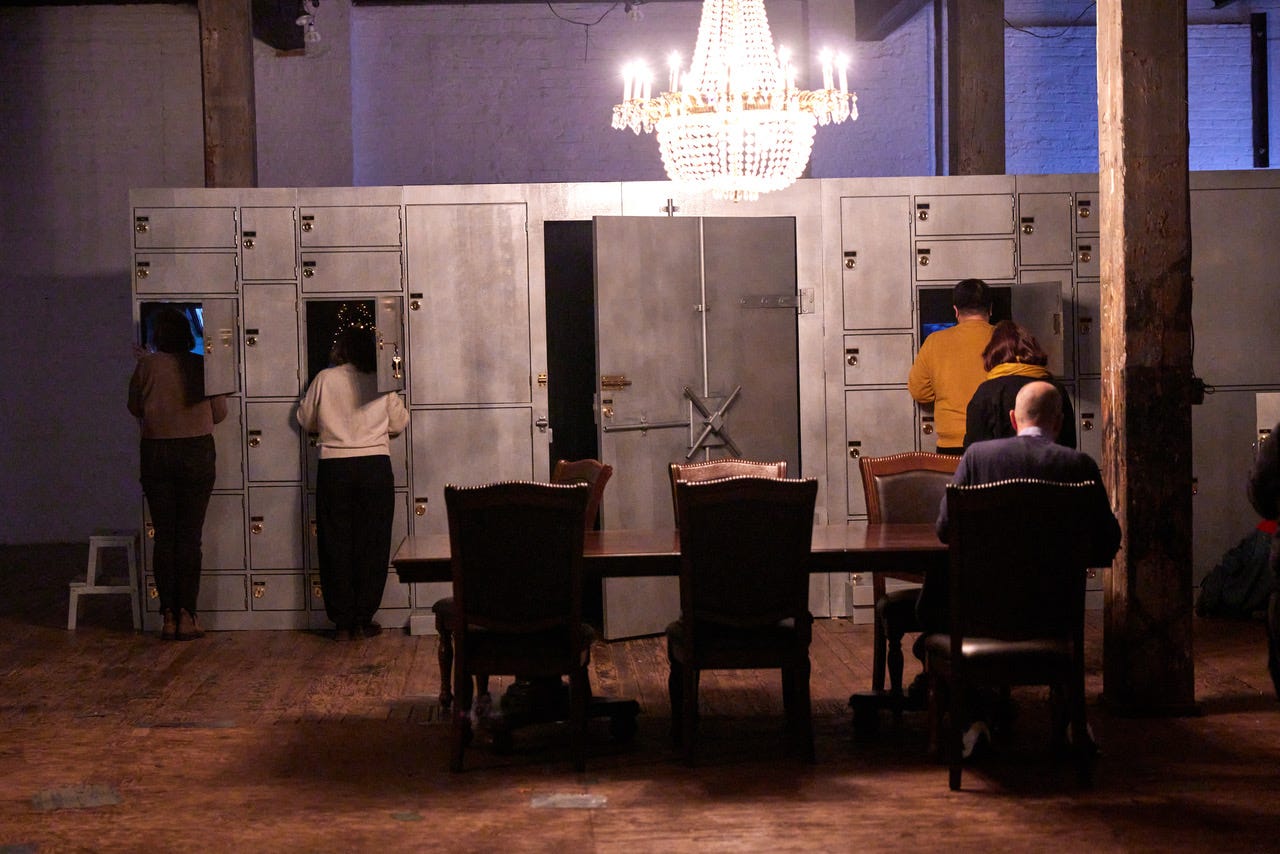
Sometimes we get an actual theme that links a lot of the work, and for this week its pieces that use detailed personal histories — both real & invented — to dramatize fractures and ills in society as a whole. I mean, sure, you could say “that’s just what good drama does!”
Yeah: we’ve got some good dramas this time out.
You’re also going to find a fair number of shows that have already wrapped their run. This time out that’s coming in three flavors: work at a Festival (specifically Under The Radar in NYC), work that ran for one weekend, and work that is making its US premiere.
I know some of you hate it when we run reviews of work that’s already run its course. Yet if we didn’t do that, there would sometimes be little to no independent record of the work at all out there. Which can make getting said work remounted anywhere. That’s part of why we run them. The other is to put the particular events and the creators on your radar so that when they pop up again in the EI listings or the newsletters you feel that little tickle in the back of you head that leads you to clicking through and picking up a ticket for next time.
On an individual level FOMO sucks — ask me about all the reviews I read of The Stone Roses and The White Stripes concerts some day — but on a scene level it can lead to the expansion of a ticket base for an artist. Which, at the end of the day, is why we do this in the first place: to grow the pie for everyone.
Looking for more? Check out last week’s edition.
Are you a creator who looks upon these reviews with envy? Okay, the positive ones, at least? Then you might want to check out our UPDATED How To Get Covered By NoPro guide.
Want to get listed in our newsletter and have your event shared with our social media following? Submit a listing to Everything Immersive.
Get the NoPro Newsletter and access to our Discord by becoming a Patreon backer today!
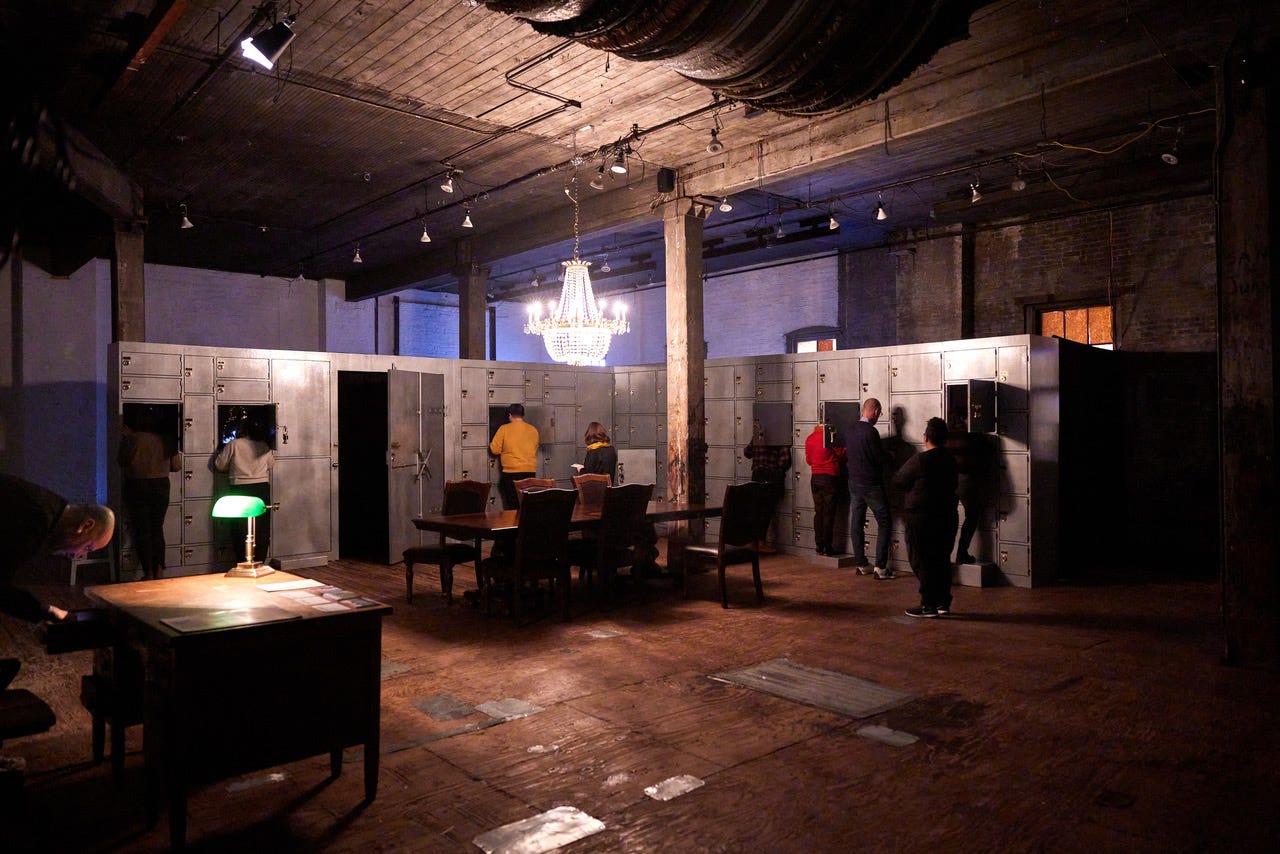
Cultural Exchange Rate — Tania El Khoury
$23.18; NYC (Under The Radar Festival); run completed
A tenderly built and theatrically ingenious new work. Within The Invisible Dog Arts Center in Brooklyn, creator Tania El Khoury has set up an L-shaped structure of lock boxes. After welcoming us serenely into the space, audience guide Nour Annan explains how the show works. We will each receive a set of 10 keys, each set numbered in a different order. Separately we will go box to box, each tracing El Khoury’s investigation into her family’s history of migration in a different chronology.
That structural disorder proves apt, since generations of criss-crossing borders has left El Khoury’s family uncertain of their own tangled history. One lock box contains a literal puzzle which, once pieced together, shows a still-incomplete generational map. Other boxes reveal video interviews, old coin collections, dessert platters, locks of hair. Some boxes are intense sensory experiences, such as one containing pungent bars of the olive oil soap used by El Khoury’s grandmother.
Most moving is a video on El Khoury’s attempts to prove her family’s Mexican lineage — originally from Lebanon, her great-grandparents migrated to Mexico, where her grandfather was born. Spotty record-keeping stymies El Khoury’s efforts, but alongside her frustration she recalls the kindness of a Mexico City official desperate to help. El Khoury’s search will continue — a family history is a vast, complicated thing, and there is always more to unlock.
— Joey Sims, NYC Correspondent
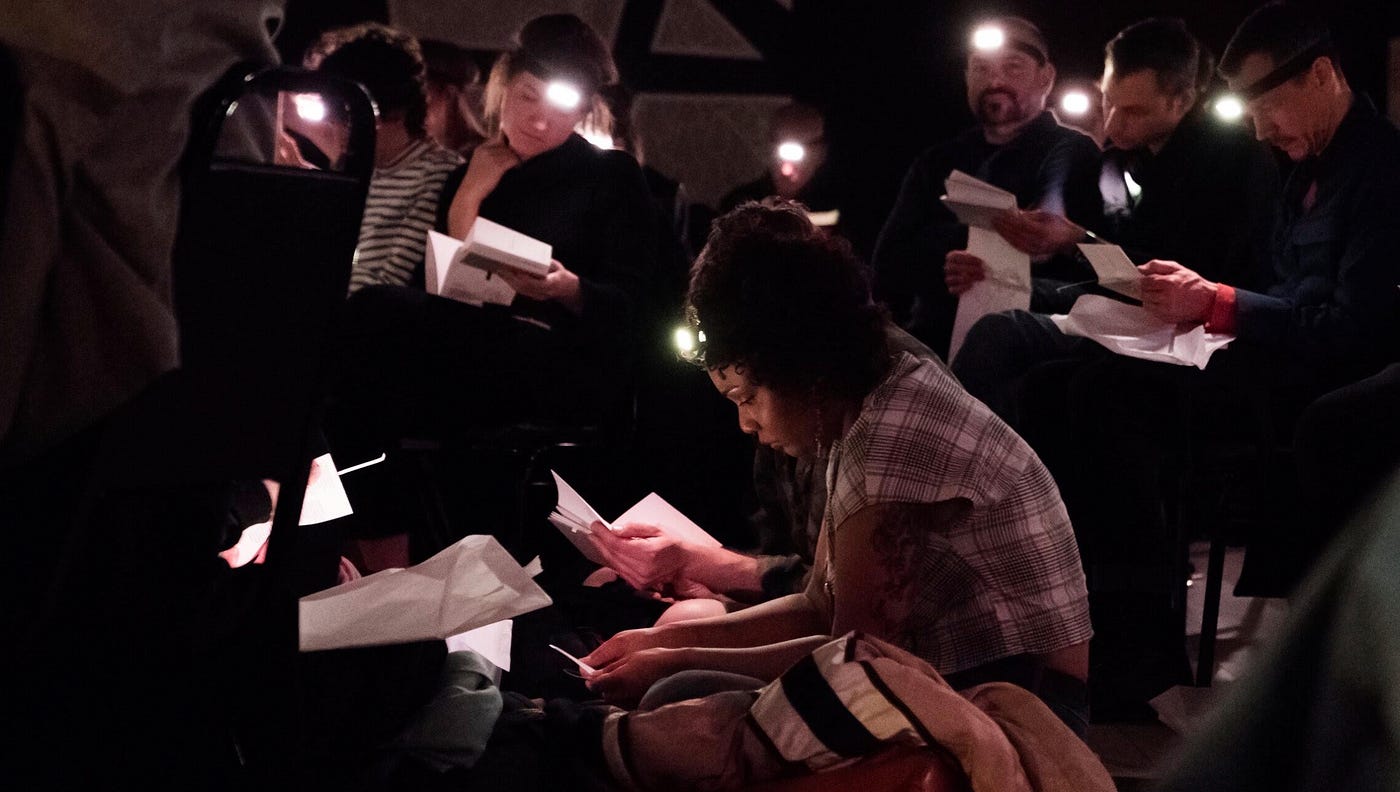
The Eagle and the Tortoise — Sister Sylvester
$25; NYC (Under the Radar Festival); Run Complete
There’s a myth that true interactions in immersive work have to be profound or deeply impactful on the story, but some of the most effective interactions can simply embody the spirit of a piece. An excellent example of this is Sister Sylvester’s The Eagle and the Tortoise, which recently played in the Under the Radar festival.
The Eagle and the Tortoise is a live documentary about the Kurdish people and the story of a Turkish woman who became an icon of leftist resistance and a political pawn. When you enter the theater, you don a headlamp and open a handmade book. A live musician starts to play and the performance moves between you reading content alone and then watching a series of video projections while listening to a live narration of Kurdish history, buried villages, and reclassified rivers. Your only interactions are reading, pointing your headlamp in a direction, and two very small personal steps you take from your seat.
What’s amazing here is how well those limited interactions work. The title comes from the story of Aeschulys’s death from an eagle dropping a tortoise on his head. The eagle and the tortoise become metaphors for two perspectives: one aerial, seeing space without detail, and one grounded, seeing details in time. The work meditates on the horrific actions that aerial viewers inflicted on the Kurdish people through genocides and wars and much subtler political oppressions, and how those struggles were understood from the grounded position of the people enduring them. By reading the book privately and then looking up at a giant screen, you keep moving between these perspectives, the limited view from the headlamp embodying the grounded position elegantly. There’s a profound sense of smallness you feel as you hear about great forces inflicting massive change and then return to the book for the story of a single woman caught up in it all.
There are so many poetic moments in this work that it would be a shame to spoil, but Sister Sylvester do a wonderful job taking what could be a sterile abstract history of tragedy and making you feel something of its impact. The lesson of The Eagle and the Tortoise for me is that you can accomplish this with gestures as minimal as turning pages and aiming headlamps. When your aim is to invoke smallness, the smallest gestures can be the most effective.
— Nicholas Fortugno, New York Correspondent
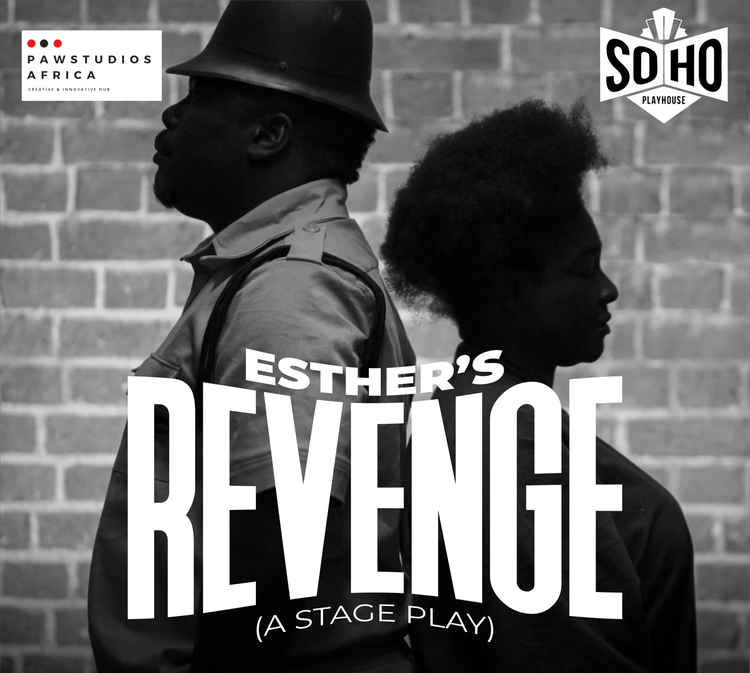
Esther’s Revenge — Tope Sanni/PawStudios Africa
$39; NYC; Run Complete
Esther’s Revenge is based on a true story from Nigeria, where Esther stood trial for having murdered her white lover in 1953. It begins with a police officer instructing six audience members to sit on stage as a jury. Esther then arrives and delivers a monologue about how and why she killed her lover, telling a shifting story of betrayal, abuse, and rape. The officer then returns and asks the jury for a verdict.
The heart of the play is Esther’s monologue, performed by Bolanle Temitope Stephen-Atitebi. It’s a powerful and commanding performance where she appeals for understanding and physically represents visceral violence through her poses and dramatic motions. It’s a disturbing thing to watch and the story (written by Kenneth Uphopho) ties together deep questions of misogyny, colonialism, and social injustice into a story of a woman trying to make a better life and being used by a foreigner in a merciless way. By Esther’s account, the murder appears justified as self defense given the violence of the final encounter, where her lover’s betrayal becomes clear and he acts with brutal force to try to silence her.
Get No Proscenium’s stories in your inbox
Join Medium for free to get updates from this writer.
SubscribeSubscribe
The point of the narrative is to give you content for the jury’s decision, but that moment of voting is not as successful. The issue is that the only thing we know of the story is Esther’s monologue, and that smartly contains some backtracking (where Esther admits she lied to gain sympathy) and some evasion (it’s never clear whether Esther was a prostitute or not). This ambiguity makes the performance powerful, but with no other reference for what happened, it’s reasonable to wonder if anything Esther said was true. The only other thing we have is the police officer, but that character is played as an aggressive functionary who just wants a guilty verdict, so he’s not trustworthy either. Without an explicit structure to the deliberation, we can’t verify or investigate anything so when the audience is asked to give a verdict, the whole piece collapses into an diffuse argument with the officer that robs him of authority and erodes all the work’s tension.
Esther’s Revenge is an important story and the actor and director nail it in the performance, but the interactivity of the jury deliberations lets the whole thing down. A version of it that brought needed structure to the final act would have been powerful rather than anticlimactic.
— Nicholas Fortugno, New York Correspondent

Sacrifice Zone: Los Angeles
Free ($15 parking); LA; through Jan 28th
Approaching the side entrance of LA’s Natural History Museum the first thing you notice is the large projection of almost impressionistically blurred freeway traffic hovering over the whale skeleton suspended from the ceiling. The skeleton is a permanent fixture, but also serves as a reminder: what we’re ultimately talking about is life and death.
Michael Bode & Paula Cizmar’s *Sacrifice Zone: Los Angeles* is a detail oriented installation that successfully mashes up digital projection, video walls, and life performance into a statement about LA’s literally & figuratively toxic relationship with oil. The centerpiece is several rooms of a framed out house that represents one of the countless that lay situated between the 110 and the 710, the most polluted part of the LA region. Which, if you know LA, is saying a lot.
There’s a lot to unpack in and around the house, and the scene is brought to life by a short sequence of scenes that illustrate the lives of the family whose home it is on the eve of the matriarch’s 70th birthday. Inside the kitchen her two adult daughters lead cousins (various audience members plucked from those floating about) through a process of writing 70 birthday cards while their kids play soccer in the yard.
Both scenes do something tricky: they balance the humanity of the characters, with their personal concerns with the overall message of the piece. This is, after all, ultimately a museum installation about the destructive nature of LA’s relationship with oil, not a family drama. Yet sticking around for a full turn of the kitchen scene — powered brilliantly by Claudia Elmore and Alejandra Villanueva — gave a sense of who this family was and how the material conditions of living in LA’s biggest sacrifice zone shaped that without ever getting preachy.
No easy feat, that.
If there’s any grumbles to be had about the piece it’s on the operations side. While the tickets have set times for entry the scenes run simultaneously and on a loop, and the front of house isn’t being strict about entry. January cold likely contributes to that. But it does mean it is possible to enter in the middle of the loop and have no idea what’s going on, and that you’ll be watching others do the same. Trust me when I say it’s worth it to hang around and wait for the loop to start over and to stick with one of the two scenes for the duration before shifting lanes. It won’t take longer than an hour to absorb the core of what’s going on, and between the loop there’s plenty to interact with in the installation itself.
— Noah Nelson, Founder & Publisher
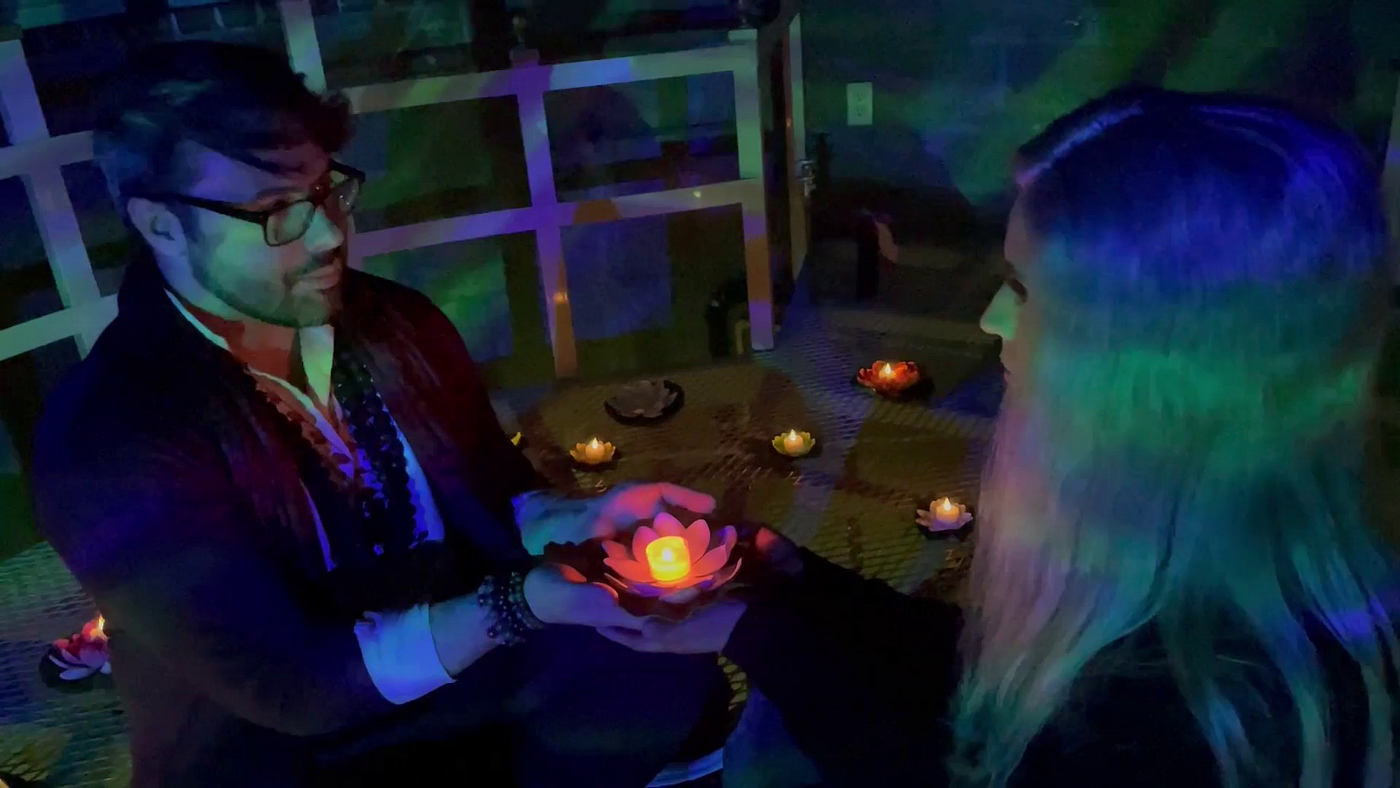
Valediction: The Art of Saying Goodbye — Firefly Tapestry Storytelling
$150, Death Valley, NV; Run Complete
Excerpt from feature length review:
Pulling up to a literal castle in the hills, we were ushered into our guest room with our heads down, as not to see any potential spoilers. Once inside, we got cozy. After driving six and a half hours, we had another five hours before our show with strict instructions not to leave our room, which sounded daunting, but with such incredible views in an large, warm, comfy room we were cozy and content. Naps and snacks were enjoyed, with a warning to bundle up for showtime, which would include a 20-minute outdoor section in 30-degree temperatures.
Finally, the knock at the door came. What transpired over the next hour and a half was a journey through memories — both joyful and heavy. There were moments of play, where laughter and banter are encouraged, and moments of grief, where hope is the undertone.
Dreams are shared, and we see through the veil of worlds as we build to an encounter with the all-knowing Archivist. They are exceedingly tall, lighting up the room and carrying a wisdom beyond words. This show is all about the art of saying goodbye. A hard goodbye. A life-changing ending of a friendship. It’s beautiful and painful at the same time. We collectively looked out into the unknown and accept it for all of its possibility, the potential for utter ecstasy as well as bitter agony.
— Briana Roecks, LA & Travel Correspondent
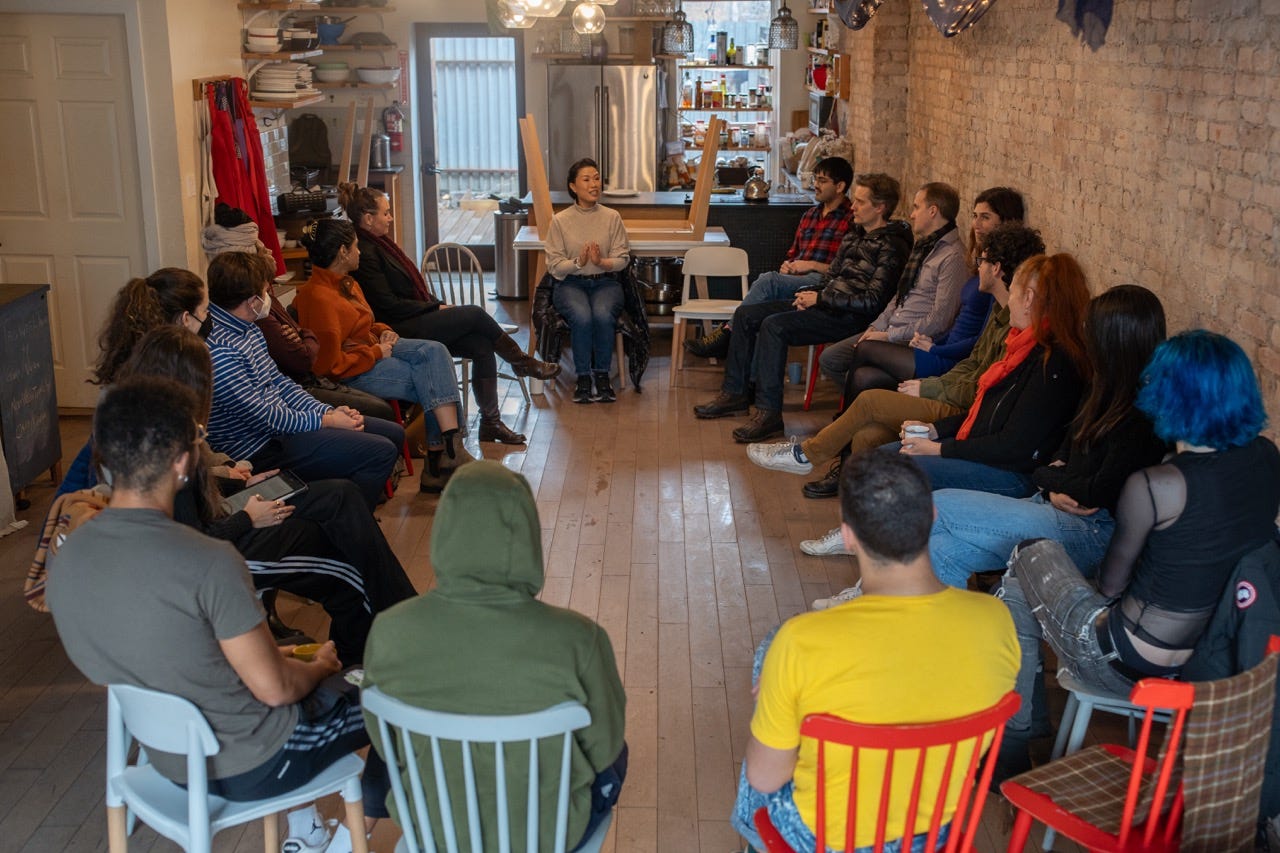
The Voices in Your Head — Grier Mathiot & Billy McEntee
$31.72; NYC; running through January 29th
It all seems friendly and familiar enough at first. In a cozy Brooklyn storefront, a support group is holding their weekly meeting. Tea and snacks are laid out. The audience sits amongst the group members — until each actor speaks, it’s hard to distinguish spectator from performer. The group leader, Gwen (Vanessa Kai) invites Regina (Daphne Overbeck) to finish the story she began telling last week.
Then Regina’s story winds its way to the abrupt twist, dropped like a punchline, that her husband recently died from gorging himself on excessive cheese. Even stranger: the group responds to this horrifying turn with uproarious laughter. What kind of support group is this?
Grier Mathiot and Billy McEntee’s smart, darkly witty new work doles out information carefully, while providing rich insight into the group’s strange members along the way. Or not so strange, as we come to realize. Grief is a confusing, destabilizing process. It can lead you down surprising roads. Inappropriate laughter may, very often, feel just as natural a reaction as tears.
Midway through the meeting, new arrival Blake (Patrick Foley, superb) bursts in and manically recounts his late husband’s death while working at a mall as Santa Claus. Blake seems deranged, an impression not helped by his quickly exiting after the story to vacuum his apartment above the meeting space. (We hear the vacuuming, in one of director Ryan Dobrin’s many brilliant little touches). I laughed at Blake — a lot. I laughed the most when the grinning, disassociated Foley allowed intense pain to shoot across Blake’s face, a momentary recognition of his unbearable grief.
Why is that funny? Not everyone in the audience laughed as much as me, which is fine — that discomfort is equal testament to this shrewd little show’s power. For me, laughter seemed the only possible response. Blame the voices in my head — both living and dead.
— Joey Sims, NYC Correspondent
Discover the latest immersive events, festivals, workshops, and more at our new site EVERYTHING IMMERSIVE, home of NoPro’s show listings.
NoPro is a labor of love made possible by our generous Patreon backers. Join them today and get access to our Newsletter and Discord!
In addition to the No Proscenium website and our podcast, and you can find NoPro on Facebook, LinkedIn, YouTube, Instagram, and in the Facebook community also named Everything Immersive.



















Discussion